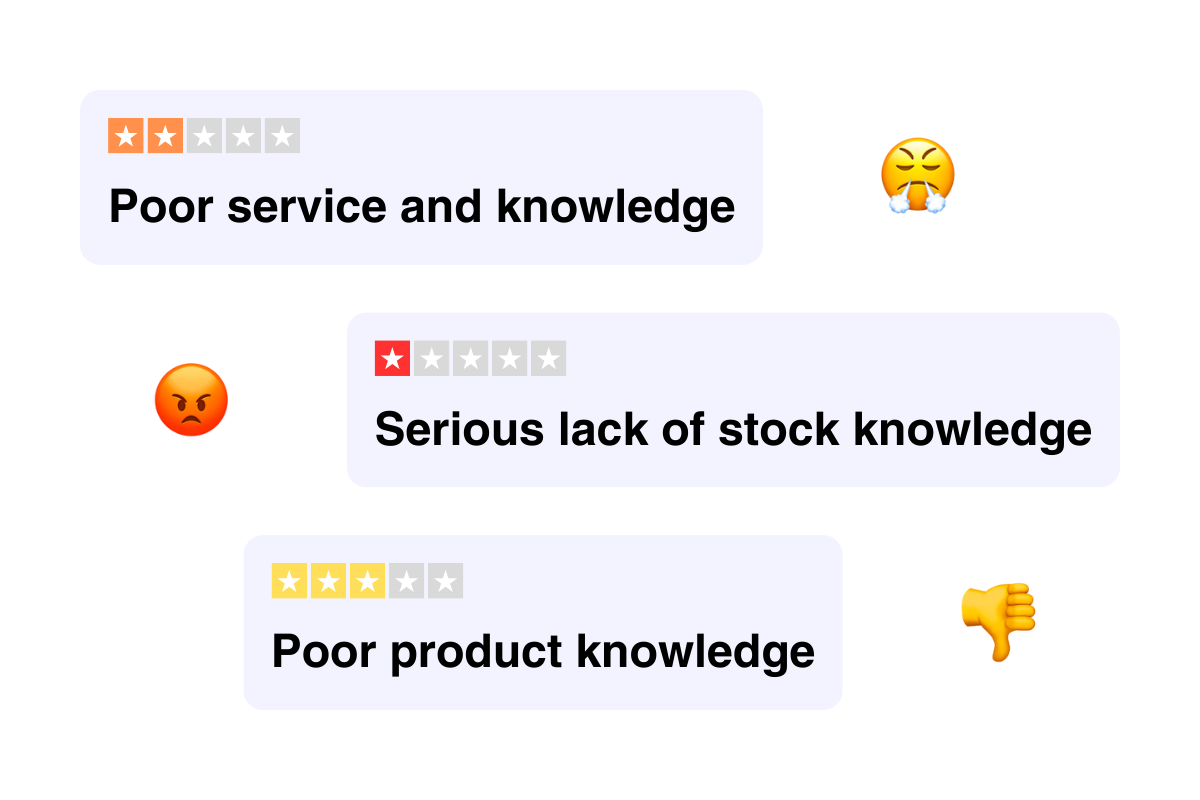Although we may not think about it often, reviews play a significant role in the many daily decisions we make. Movie selections, restaurant choices, online purchases—all are influenced by customer reviews that help us determine our own choices. As much as we like to think of ourselves as independent thinkers, our decision-making processes are easily influenced by the opinions of others, as with word-of-mouth recommendations by family and friends. But no more so when these opinions are given in large volumes, as in online reviews.
It’s therefore, no surprise that businesses place such value on customer reviews, an area of focus made evident by the hundreds of people monthly who search ‘how to get good reviews from customers’, ‘how to improve customer reviews’, ‘how to get more reviews’—and other variations. And if you’ve found this blog, then you might be one of those people (welcome!).
In any case, there are clearly a lot of people concerned with increasing their number of reviews and improving the quality of those reviews. That’s where we can help.
Keep reading to find out why customer reviews are so important, and how you can improve yours.
Why customer reviews are important
Put simply, customer reviews can make or break a business. Their impact is far-reaching, with only a few business areas that aren’t in some way influenced by the opinions of customers. Let's take a closer look.
They drive customer acquisition and retention
When people read positive reviews, they are more likely to excitedly visit your business or try out your service and find out if it’s too good to be true. This presents you with the opportunity to acquire new customers.
Once reviews have gotten people through the door, it’s then up to your customer experience (as delivered by your employees, contractors, and customer service representatives) to keep them there. An outstanding experience will improve customer retention, and because returning customers are up to 10x more profitable than new ones, revenue also increases.
They impact sales
Statistically, the relationship between reviews and sales is apparent. 95% of customers read online reviews before buying a product, and 94% said bad reviews caused them to avoid a business. In other terms: good reviews drive sales and bad reviews reduce them.
But don’t just take it from us—evaluate your own experience. Chances are you’ve purchased products on Amazon based on the review rating and the amount of reviews a product has received. That’s because we trust the opinions of those who have already used the product, and we feel more secure in our purchase when thousands of people have bought the same thing.
Online reviews are especially potent for online purchases as customers are unable to interact with a product and test it out for themselves.
They help optimize the business
Every cloud, or in this case every bad review, has a silver lining. Reviews aren’t just the opinions of customers—they’re valuable data. They highlight common themes and problems, helping you understand what actions to take and areas to optimize.
For example, if customers are consistently complaining about the spaghetti, then the restaurant owner can take that information and tweak the recipe or remove the dish entirely. While some reviews might be unhelpful, the vast majority offer useful insight.
They increase revenue
Here’s an example of a customer journey after reading a review:
They read a positive review or hear a positive word-of-mouth recommendation from a friend or family member, and decide to try your service out. They make a purchase, enjoy the experience so much that they become a repeat customer, and decide to share their positive experience with others. During that journey the customer has increased revenue in 3 different ways; direct sales, repeat business, and customer acquisition. Customer reviews cause a domino effect that results in an increased bottom line. In fact, for every one-star increase that a business gets on Yelp, they see a 5-9% increase in revenue.
How to influence customer reviews: Employee training
There are various ways to influence customer reviews that range from streamlining your review process to responding to negative feedback. However, the most effective way to address the common themes identified in reviews is by optimizing your employee training.
Your employees are the heart and soul of your operation, and the most common themes identified in customer reviews are centred around customer service and experience. —those which your employees are responsible for delivering.
And the value of customer service and experience can’t be understated. 96% of customers say excellent service builds trust, while 82% say a positive experience makes them more likely to purchase again. In fact, businesses that view customer service as a value center rather than a cost center achieve 3.5x more revenue growth.
So, let's take a closer look at how employee training can optimize your business and influence reviews.
Problem: Inadequate product/service knowledge

It’s important that your employees present themselves as experts when communicating with consumers. A sales associate who can’t answer any product-related questions will not only prevent a sale but diminish the entire customer experience. In fact, 46% of all consumers will abandon a brand if the employees are not knowledgeable.
If you’re reading this and are confident your employees are knowledgeable, then consider the customer’s perspective—83% believe they know more than store associates. In any case, your workforce can always know more.
Solution: Leverage microlearning to engage your employees and increase knowledge retention by up to 50%. By presenting information in bite-sized chunks, you adapt to the modern workers shortening attention span and optimize their ability to process necessary information.
Problem: Communication skills
Your workforce can have all the knowledge in the world, but it’s pointless if they’re unable to effectively communicate it. As they say ‘It’s not what you say, it’s how you say it.’
Communication is a major theme among negative reviews, particularly surrounding empathy and politeness. These clearly matter to the consumer, with 68% of customers highlighting politeness as the key to great customer service.
Solution: Introduce role-play into your training. The closer you can get to replicating a real-world scenario, the better. And make sure the situations are diverse enough to reflect actual customer service. Customers sit along a spectrum—some are polite, others not so much. Role-playing is a proven way to improve communication and foster a more empathetic workforce.
Problem: Inconsistent service
.png?width=1200&height=800&name=Poor%20Trustpilot%20Reviews%20(1).png)
If you’re a business that employs an omnichannel approach, then it’s important to optimize service across every touchpoint. It’s not just what your customers want, it’s what 90% of them expect. And when businesses fail to meet this expectation, it’s reflected in the reviews they receive.
Companies that roll out an inconsistent omnichannel approach experience a 33% lower customer retention rate and a lower increase in annual revenue. In contrast, those with optimized omnichannel strategies see a 9.5% year-over-year increase in annual revenue
Solution: Leverage mobile training to easily roll out standardized training at scale. Mobile learning is your opportunity to make sure that your representatives on the ground coordinate with your brand ethos. The quality of service provided and the interpersonal skills your employees demonstrate—mobile learning can ensure these are consistent across every touchpoint, giving customers the most accurate image of your brand.
Case Study: Urban

Urban is the UK’s leading home massage app that boasts a 4.3/5 star rating on Trustpilot from over 2000 reviews. How do they leverage practitioner training to influence and maintain this rating?
The company needed an optimized onboarding process that could ensure practitioners were up to scratch on brand protocol prior to meeting customers in person. After all, they are representing the company, so they need to do a good job.
eduMe (that’s us!) provided Urban with a way to improve operational efficiency by enabling remote onboarding at scale and providing standardized knowledge delivered conveniently via practitioner’s smartphones.
But the benefits of working with eduMe extended beyond the initial onboarding phase:
- 85% learner completion rate - a result of providing engaging content at relevant touchpoints. Users received push notifications when training was required and could access knowledge hubs in order to revisit relevant training.
"We know practitioners are using the courses and completing them at a high rate" Peter Dixon, Head of Operations, Urban
- Practitioner enthusiasm around training due to eduMe's engaging microlearning, features and lesson formats.
"We know our practitioners absolutely love these courses. We have a survey at the end of each course which allows the practitioner to give a satisfaction rating and we so far have got a 99% satisfaction rate around eduMe courses" Peter Dixon
- A reduction in training time as a result of training being delivered in this manner vs. in person.
Now boasting an optimized training program, Urban naturally experienced a number of business benefits:
- 35% reduction in non-booking related interactions— Practitioners now possess the relevant knowledge and training to help customers, resulting in fewer questions for Urban's support team.
"This frees us up so our hero support team can spend a lot more team on outreach and optimization as opposed to reactive queries" Peter Dixon
- 4.3/5 customer rating maintained - Despite business expansion, quality of service remains high due to engaging and standardized training that ensures a consistent skill level among practitioners.
eduMe is the platform of choice for your frontline workforce. With the ability to seamlessly integrate into existing work tools, and deliver engaging, bite-sized content when employees need it most, eduMe optimizes your workforce without any hassle.
Contact us now to see if we can help!





